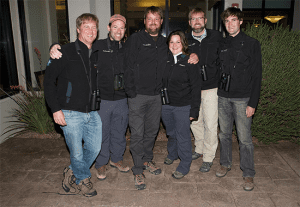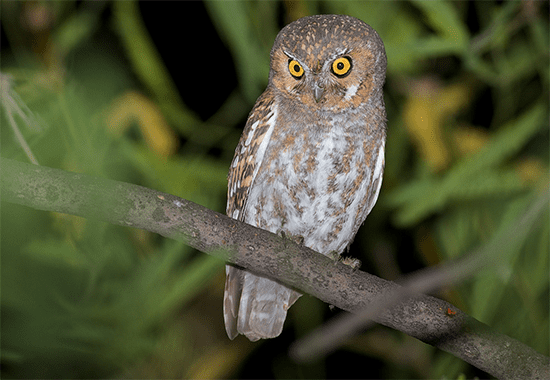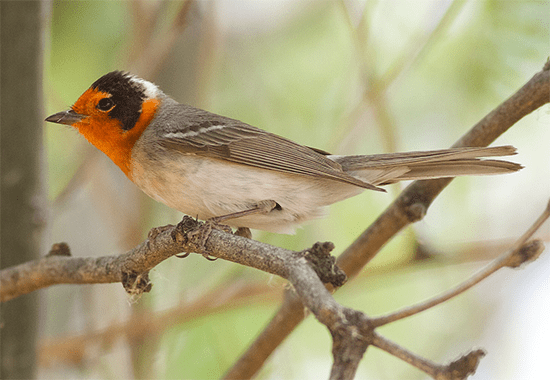Team Sapsucker Goes “Gigante” With 275 Species on Big Day 2014
May 6, 2014
Celebrating an Olive-sided Flycatcher in California. 
An all-smiles Team Sapsucker rolls on through their Big Day. 
At each stop, everyone piles out of the car and starts to scan. 
Elf Owl was bird #3 of the day. 
Red-faced Warbler is one of many Arizona specialties. 
Lesser Nighthawk by Tom Johnson. 
Dusky-capped Flycatcher, by Tom Johnson. 
Awake and giddy on the Big Day.
On Saturday, May 3, 2014, Team Sapsucker completed their “El Gigante” Big Day run with an astonishing 275 species in 24 hours. The total is the highest Big Day score ever reported from the region, and in North America it is second only to the record the Sapsuckers set themselves in Texas, last year.
The route started at midnight outside Tucson, Arizona, with #1, a rare Ferruginous Pygmy-Owl. One flat tire, a vehicle change, and three encounters with the Border Patrol later, the day wrapped up in La Jolla, California, at 10:38 p.m., with the shrill call of #275, a Wandering Tattler.
Big Day is the Cornell Lab’s biggest conservation fundraiser of the year, and their tally is spectacular for what was essentially an untried, largely hypothetical route. After last year’s nearly perfect 294-species Big Day in Texas, the team turned its attention to the 500 bird-rich miles connecting Tucson and San Diego. Though the team had only a scant week to scout for reliable locations in unfamiliar country, they estimate that they finished the Big Day with fewer than 10 painful “dips,” or expected-but-missed species.
And backing up those misses were clutch sightings thanks to Chris Wood’s birding-while-driving skills (Greater Roadrunner, Gilded Flicker), Tim Lenz’s long-distance-gulling ability (Lesser Black-backed Gull), Jessie Barry’s whistling prowess (Montezuma Quail), Brian Sullivan and Andrew Farnsworth’s unsurpassed raptor vision, and Marshall Iliff’s call-note reflexes (Wandering Tattler).
“We’re extraordinarily pleased,” Iliff said of the day’s birding. “It’s such a huge challenge to do that much bird watching that efficiently. But with the number of past Big Days we’ve done together and the teamwork we’ve developed, we don’t even have to talk about it anymore. We just know how to get people out of the car quickly, how to get people on a bird, how to respond to the driver. It’s like clockwork.”
Seven Owls Before Dawn

The day started at midnight with three owls one after another: Ferruginous, Great Horned, and Elf. As the team shone their lights into a sewage pond looking for a sleeping Neotropic Cormorant and Ring-necked Duck they aroused the curiosity of the Border Patrol for the first time that day. “We just told him that we were doing a conservation fundraiser,” Chris said. “So many people go birdwatching around there that he immediately understood and wished us good luck. And then Marshall went back and asked him where an all-night gas station was—so it was kind of a lucky stop.”
Their first true morning spot, and possibly the biggest gamble of the day, was the desert grasslands. The Sapsuckers planned to be in place just before dawn, to hear the very first Grasshopper Sparrow, Botteri’s Sparrow, and Eastern Meadowlark songs, and to use the first rays of light to see a Chihuahuan Raven on its nest. The price they paid for these species was to spend the next hour of precious morning birding time driving to the top of Mt. Lemmon. But the gamble paid off, and the team got almost everything they expected in both the grasslands and the mountains, including Zone-tailed Hawk, Inca Dove, and Canyon Towhee.
By 9:51 a.m.—a full four minutes ahead of schedule—the team had left Tucson behind and were pointed toward the Salton Sea, where Farnsworth and Sullivan took over the lead, a little after midday. “Basically, our strategy was to go to this incredibly birdy location and spend as little time there as possible,” Farnsworth said. Despite its thousands upon thousands of shorebirds and waterfowl, the Salton Sea involved more uncertainty than the Arizona spots. The birds are migrants, and they’re not tied to one reliable territory where they can be found time after time.
The team took the approach of visiting three or four good vantage points and spending 8 or 10 minutes at each. Everyone piled out of the vehicle and set up scopes, with individual roles assigned: look for ducks; look for phalaropes; look for Stilt Sandpipers; pick through gulls; scan for the one rare Ruff at the edge of the tall vegetation (which they found). Then get back in the car and keep going.
Birding the Flats

At the Salton Sea visitor center, Barry’s finely tuned ear picked up a high-pitched hissing that turned out to be air streaming out of the left rear tire. While half the team scoured the bushes for Common Ground-Doves, the other half put their contingency plan into effect, trading vehicles with scouter/support driver/photographer extraordinaire Tom Johnson. They tore out of the parking lot, leaving Johnson to discover that there was no jack in the rental vehicle he’d been left with.
By late afternoon they were through the mountains (having reluctantly left Mountain Quail and Gray Vireo behind them, but picking up Black-chinned Sparrow, the newly split Bell’s Sparrow, and a late Golden-crowned Sparrow). Now they were in chaparral, finding birds like Wrentit, California Thrasher, and California Towhee—and fighting the sun as they drove westward.
They stopped by a San Diego park and raised a few eyebrows among the Saturday afternoon picnickers as they dashed around the pond looking for one Greater White-fronted Goose amid scores of domestic geese and Mallards. When they found it, the bird was standing next to their vehicle, hidden by a small bush. “It was even calling the entire time—and they have a very distinctive call,” Iliff said, “but we didn’t hear it among the cacophony of the introduced geese.”
Even the dips weren’t total disasters. A trip into an obliging birder’s backyard failed to turn up the Lawrence’s Goldfinch that had been there all week, but the team did pick up Costa’s Hummingbird and a passing Peregrine Falcon. California Quail and Inca Doves seem to have become strangely rare along the route, but the team managed to pick them up. Missing the relatively common Ladder-backed Woodpecker in Arizona will go down as one of the most painful, along with Least Bittern, which is not just a hard bird to get but now something of a thorn in the Sapsuckers’ side. Year after year, they find the bird repeatedly during scout week only to miss it on the day.
A Call You Could Recognize in Your Sleep
They raced up to a vista of San Diego Bay just as the sun was setting and found themselves squinting for Least, Elegant, and Royal Terns against a sliver of setting sun. They also found Brant and Greater Scaup, but missed the relatively common Surf Scoter. Later, they found out Johnson had been watching one in the near distance while the team scanned farther out with their scopes. Big Day rules prohibited Johnson from saying anything during the event.
With the light draining out of the day the team swung by their California Gnatcatcher spot right on the Mexico border (giving them chance to say hello to the Border Patrol one more time). They dropped down into the Tijuana River Valley and rolled up at last to the Pacific Ocean to nab Clapper Rail, Red-throated Loon, Little Blue Heron, and to scan the horizon in the hope of a scoter or jaeger (which didn’t materialize).
After dark, the team drove up to La Jolla, where they knew they could see Brandt’s Cormorants in the dark. Energy levels were flagging. “Marshall was pretty catatonic by that point,” Barry said, “but when that Wandering Tattler started calling he was still able to scream it at the top of his lungs to make sure we all knew about it and didn’t miss it.” That was at 10:38 p.m., just about 24 hours since the team had gotten up for the drive out to their starting point. It was bird number 275.

Team Sapsucker and all of us at the Cornell Lab would like to thank everyone who threw their support behind this groundbreaking day of birding. If you’d like to donate to the cause, there’s still time.
Team Sapsucker also thanks all the scouters and local birders who gave their time and knowledge to help them put together such a successful route. In particular, they appreciate the expert scouting help of Andy Guthrie, Ken Rosenberg, and Tom Johnson (who also drove support and took photographs during the Big Day).
For route advice and local bird intel they send big thanks to John Arnett, Linda Benzinger, Barbara Carlson, Andrew Core, Laurens Halsey, Jen Johnson, Eric Kallen, Ken Kurland, Andy Laurenzi, Paul Lehman, Guy McCaskie, Gary Nunn, Scott Olmstead, Jerry and Cookie Popham, Scott Richardson, Gary Rosenberg, Will Russell, Matt Sadowski, Christian Schoneman, Tim Spahr, Mark Steward, Mark Stevenson, Naupaka Zimmerman, and the folks at the Santa Rita Lodge in Madera Canyon. They’d also like to thank the great community of eBirders and regional editors living in Arizona and California.
For anyone considering a similar run, or just curious about this epic day of birding, here’s the official list:
(All photos by scouter/support driver/photographer extraordinaire Tom Johnson.)

All About Birds
is a free resource
Available for everyone,
funded by donors like you
American Kestrel by Blair Dudeck / Macaulay Library












